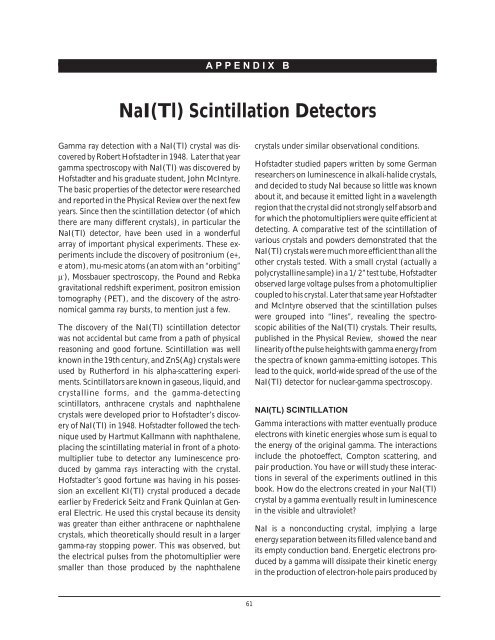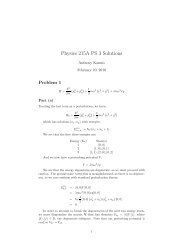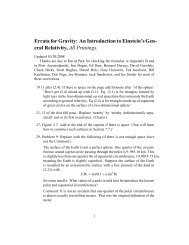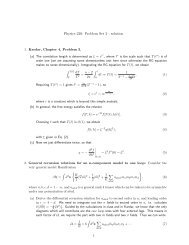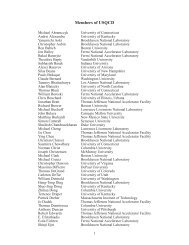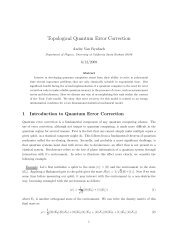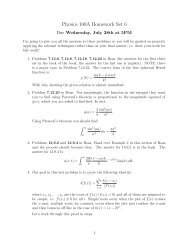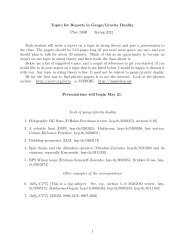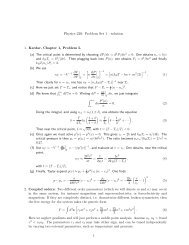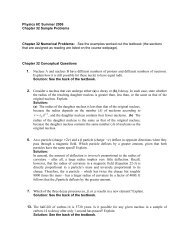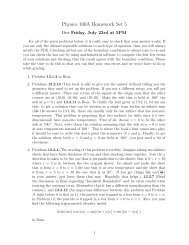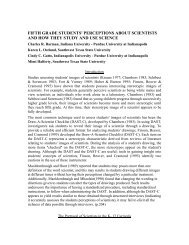Nuclear Spectroscopy
Nuclear Spectroscopy
Nuclear Spectroscopy
Create successful ePaper yourself
Turn your PDF publications into a flip-book with our unique Google optimized e-Paper software.
A P P E N D I X B<br />
NaI(Tl) Scintillation Detectors<br />
Gamma ray detection with a NaI(Tl) crystal was discovered<br />
by Robert Hofstadter in 1948. Later that year<br />
gamma spectroscopy with NaI(Tl) was discovered by<br />
Hofstadter and his graduate student, John McIntyre.<br />
The basic properties of the detector were researched<br />
and reported in the Physical Review over the next few<br />
years. Since then the scintillation detector (of which<br />
there are many different crystals), in particular the<br />
NaI(Tl) detector, have been used in a wonderful<br />
array of important physical experiments. These experiments<br />
include the discovery of positronium (e+,<br />
e - atom), mu-mesic atoms (an atom with an “orbiting”<br />
µ - ), Mossbauer spectroscopy, the Pound and Rebka<br />
gravitational redshift experiment, positron emission<br />
tomography (PET), and the discovery of the astronomical<br />
gamma ray bursts, to mention just a few.<br />
The discovery of the NaI(Tl) scintillation detector<br />
was not accidental but came from a path of physical<br />
reasoning and good fortune. Scintillation was well<br />
known in the 19th century, and ZnS(Ag) crystals were<br />
used by Rutherford in his alpha-scattering experiments.<br />
Scintillators are known in gaseous, liquid, and<br />
crystalline forms, and the gamma-detecting<br />
scintillators, anthracene crystals and naphthalene<br />
crystals were developed prior to Hofstadter’s discovery<br />
of NaI(Tl) in 1948. Hofstadter followed the technique<br />
used by Hartmut Kallmann with naphthalene,<br />
placing the scintillating material in front of a photomultiplier<br />
tube to detector any luminescence produced<br />
by gamma rays interacting with the crystal.<br />
Hofstadter’s good fortune was having in his possession<br />
an excellent KI(Tl) crystal produced a decade<br />
earlier by Frederick Seitz and Frank Quinlan at General<br />
Electric. He used this crystal because its density<br />
was greater than either anthracene or naphthalene<br />
crystals, which theoretically should result in a larger<br />
gamma-ray stopping power. This was observed, but<br />
the electrical pulses from the photomultiplier were<br />
smaller than those produced by the naphthalene<br />
crystals under similar observational conditions.<br />
Hofstadter studied papers written by some German<br />
researchers on luminescence in alkali-halide crystals,<br />
and decided to study NaI because so little was known<br />
about it, and because it emitted light in a wavelength<br />
region that the crystal did not strongly self absorb and<br />
for which the photomultipliers were quite efficient at<br />
detecting. A comparative test of the scintillation of<br />
various crystals and powders demonstrated that the<br />
NaI(Tl) crystals were much more efficient than all the<br />
other crystals tested. With a small crystal (actually a<br />
polycrystalline sample) in a 1/2” test tube, Hofstadter<br />
observed large voltage pulses from a photomultiplier<br />
coupled to his crystal. Later that same year Hofstadter<br />
and McIntyre observed that the scintillation pulses<br />
were grouped into “lines”, revealing the spectroscopic<br />
abilities of the NaI(Tl) crystals. Their results,<br />
published in the Physical Review, showed the near<br />
linearity of the pulse heights with gamma energy from<br />
the spectra of known gamma-emitting isotopes. This<br />
lead to the quick, world-wide spread of the use of the<br />
NaI(Tl) detector for nuclear-gamma spectroscopy.<br />
NAI(TL) SCINTILLATION<br />
Gamma interactions with matter eventually produce<br />
electrons with kinetic energies whose sum is equal to<br />
the energy of the original gamma. The interactions<br />
include the photoeffect, Compton scattering, and<br />
pair production. You have or will study these interactions<br />
in several of the experiments outlined in this<br />
book. How do the electrons created in your NaI(Tl)<br />
crystal by a gamma eventually result in luminescence<br />
in the visible and ultraviolet?<br />
NaI is a nonconducting crystal, implying a large<br />
energy separation between its filled valence band and<br />
its empty conduction band. Energetic electrons produced<br />
by a gamma will dissipate their kinetic energy<br />
in the production of electron-hole pairs produced by<br />
61


